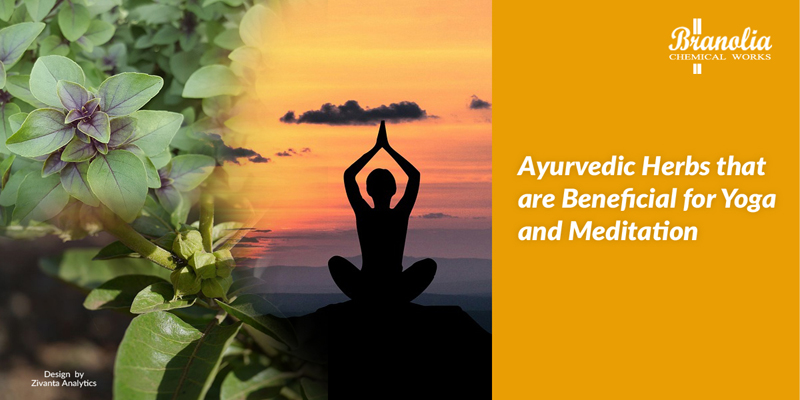
Yoga is coined from the Sanskrit word “Yogah” which means “to unite”. On a spiritual note, these are certain practices that assist in the “union” of the mind and body, helping one to detach himself from the materialistic world and unite with the omnipotent universal energy. Meditation is an integral aspect of Yoga. It signifies a mental exercise that helps in developing one’s concentration and involves relaxation and awareness of the mind. Yoga is one branch of Vedic science and the ancient Indian system of medicine, Ayurveda, is another offshoot of Vedic science. Ayurveda rests on the principle of healing the human body of its problems, with herbal therapeutics whereas Yoga focuses on reviving the consciousness of the mind. However, practicing Yoga and Ayurveda together improves the underlying mechanisms of our body and hence it helps in bringing forth an unimaginable transformation into our lives.
Ayurveda specifies certain herbs which provide enormous assistance in performing Yoga, both at a physical and mental level. Certain herbs like Aswagandha, Brahmi, Tulsi, Pipul, Amlaki, Haritaki, Shilajit, and Shatavari can be easily added to the diet of a person practicing Yoga. These herbs not only prevent or treat ailments but also helps in rejuvenation of the mind, renews our vitality and awakens our senses.
We take a look at some of the nutritive herbs that form an essential constituent of a diet that can be easily followed by yoga practitioners
Aswagandha: Aswagandha (Withania somnifera) is a flowering plant that grows extensively in India. This herb is responsible for relieving stress and anxiety as it is a well-known adaptogen. Since Aswagandha plays a primary role in strengthening the musculature of the body and enhances its vitality, it brings steadiness in the yoga postures and breathing exercises that are practiced. Aswagandha also works as a mild sedative, thus calming the mind to facilitate meditation.
Aswagandha is also utilized in two of the products of Branolia Chemical Works, which are Branolia’s Kulerron and Branolia’s HoneyGuard.
Tulsi: (Ocimum tenuiflorum) is an aromatic shrub that is indigenous to the Indian subcontinent. Even though this medicinal plant has always been effective against cough and cold, it is endowed with certain properties that stimulate the mind and the senses as well. It helps in clearing all the channels and assists in cerebral circulation. Thus, tulsi cultivates our perception and assists in the process of meditation.
Tulsi is also infused in Bitocough, which is a tonic manufactured by Branolia Chemical Works.
Pipul: Pipul or long pepper, is one of the indigenous spices that is often used in Ayurvedic concoctions. Pipul is useful in combating cough and cold but it has other properties as well. It is a rejuvenating agent that strengthens and nourishes the different systems of the body and promotes proper blood circulation. These rejuvenating qualities of Pipul repose the mind and this facilitates the process of meditation.
Pipul is also one of the key ingredients of Bitocough, which is a tonic aimed at curing cough and cold.
Brahmi: (Bacopa monnieri) This perennial herb reposes the mind and imparts a cooling effect to the brain and the nervous system. Brahmi enables a person to gain concentration, builds a sharp memory, strengthens learning abilities and also instills a sense of contentment and peace to one’s mind. It is on account of these properties, that Brahmi can be used to compose one’s mind for meditation.
The goodness of Brahmi is brought forth by Branolia, which is a tonic that aids the healthy functioning of the brain.
Amlaki and Haritaki: Amlaki (Phyllanthus emblica) is the fruit of a deciduous tree that is native to India. It is a powerhouse of vitamin C. It contains substances that are antioxidants and is an important agent that detoxifies our body. Haritaki (Terminalia chebula) is another cleansing agent that eliminates all the toxic substances from our body. In order to fulfill the physical demands of intense yoga and meditation, people practicing yoga prefer Amlaki and Haritaki to purify their bloodstream.
Haritaki is also present in Bellytone and it is coupled with Amlaki and Bibhitaki in Livonia. Both these tonics are products of Branolia Chemical Works.
All these herbs, which can be the essential supplements of a diet followed by yoga practitioners, have acquired their place in some of the most popular products of Branolia Chemical Works. Therefore, we see Branolia Chemical Works continuing its legacy in manufacturing cost-effective products with precise herbal therapeutics and curing ailments that will lead to our fruitful sustenance.



